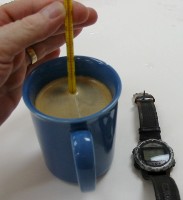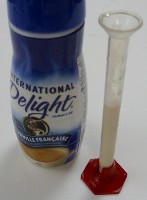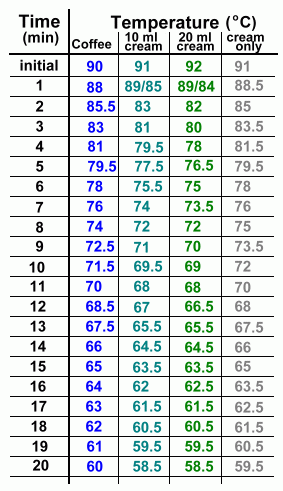|
I conducted an actual experiment so that you could see what one looks like. Experiments are usually the result of curiosity and questions about something. Here's my question: "If you want to drink coffee at the warmest possible temperature, but aren't able to drink it for a period of time, should you wait to add the creamer, or add it immediately? In 15 minutes, which would give you the warmest coffee?" Purpose: To determine the effect on the cooling rate of coffee when creamer is added. Hypothesis: I believe that coffee will cool more slowly once the creamer has been added. In other words, after a period of time, the coffee with creamer will be warmer than black coffee would have been ... so it wouldn't make sense to add the creamer later and make it even cooler. Method: I will heat water and make instant coffee, and then measure its temperature every minute for a period of 20 minutes. I will then do the same for coffee with 10 ml of creamer added, and once again for coffee with 20 ml of creamer added. 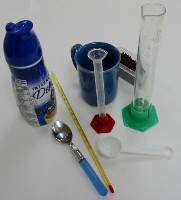 I chose the design and apparatus such that anyone could do this experiment. I picked French Vanilla liquid creamer as a typical coffee whitener, and used instant coffee. A microwave oven was used to heat the water in a coffee cup.
I chose the design and apparatus such that anyone could do this experiment. I picked French Vanilla liquid creamer as a typical coffee whitener, and used instant coffee. A microwave oven was used to heat the water in a coffee cup.I measured all amounts using equipment from our school lab, but could just as easily have used kitchen measuring implements. Similarly I used a lab thermometer to record the temperatures, but a candy thermometer would have worked just as well. A watch was used to measure times, and all information was recorded on paper. In conducting an actual experiment, you should use a notebook and keep all your records, even if you mess up and have to redo something. Variables:
I controlled:
We were careful to keep the thermometer from touching the inside of the cup, as this would give false temperature readings. The thermometer was held the same way, at the same spot, for every trial. Repeated Trials: A thorough experiment would repeat all the trials several times, and show that data. I did repeat every test; the data was very similar each time. For simplicity I am omitting the extra data here, but you should include data from repeat trials in any experiment you do. Sources of Errors: - The precision with which I measured the temperatures is based on the smallest unit marked on the thermometer, which was one degree. As a result, there should be no more than one half a degree in error in these readings. - The time readings were digital, and so could have been off by as much as one second, allowing for time to look between the watch and the thermometer. This is insignificant. Results:
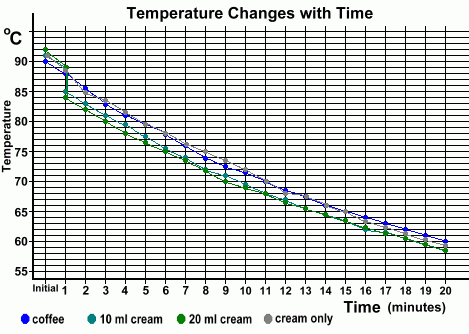 Observations and Conclusions: The blue line is the black coffee cooling curve. When you add creamer to the coffee, the temperature immediately drops, but not by a great amount. This is because we are only adding a small amount of creamer to the coffee, and it's not very cold. The amount of creamer added in each test (10 ml and 20 ml) was meant to simulate real conditions. Adding very cold creamer would increase the initial drop in temperature. This is additional testing that should be done to complete this experiment; every experimental result should suggest new things to check out. I didn't follow up on this, but you should in any experiment you do. The first thing I noticed in the graph above is that the cooling curves for all the samples are very similar, if not identical, after about only two minutes. Black coffee, coffee with creamer, or even straight creamer, all seem to cool at the same rate. The only difference is that in the samples with creamer added to coffee, the temperatures are always a few degrees cooler than the black coffee; however, the difference in temperature is only a few degrees ... not enough to notice when drinking ... and the difference gets smaller as time passes. Moreover, look at the curves for black coffee (blue) and straight creamer (grey). They are just about identical! The above observations led me to conclude that our hypothesis was incorrect. It doesn't matter whether you add creamer to your coffee or not ... the cooling rate will be the same after the first few minutes if you add the creamer a minute after you get the coffee. Waiting to add the creamer until you're ready to drink the coffee (maybe after 10 minutes) does not make sense, since at that point the temperature would drop well below that of coffee where the creamer was added at the beginning. To keep your coffee warmer longer, add the creamer within the first minute. (Note that this is not because coffee with creamer cools more slowly, as we guessed; it's because after 10 minutes or so there won't be much difference between the temperature of the black coffee and the temperature of the coffee with creamer added right away; adding creamer to the black coffee then will make it cooler than if you'd added it originally). Here's another place where additional testing should be done. I should have compared the temperatures of coffee with creamer added at the start to coffee with creamer added after 10 minutes or so. Don't be afraid to go back and do more testing to answer additional questions or back up your conclusions. The second thing I remarked on is how similar the cooling curves are for all the liquids. The thickness of the mixture seems to have had no noticeable effect on the rate of cooling, after a few minutes or so. Since you might expect some sort of difference to have occurred, it is now necessary to come up with some sort of explanation for this result. I suspect that the cooling rate does not change noticeably because creamer is mostly water; the difference in viscosity between coffee and even straight creamer is probably too small to affect the rate of cooling. This suggests some further research we might do to see if we're correct. We won't do it here, but it's something you should do in any experiment you conduct. |
